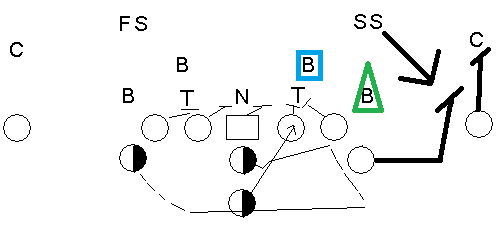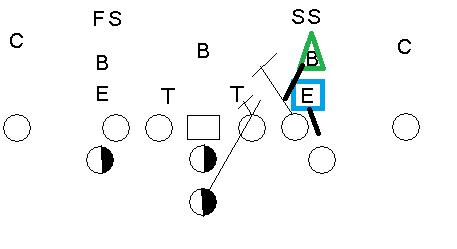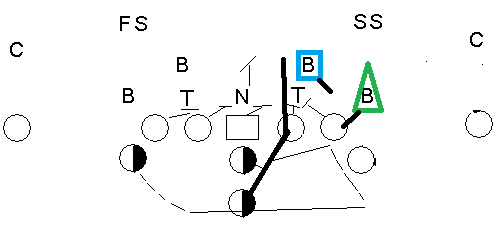The B back is where it all begins! The defense has to fear him getting the ball, breaking a weak arm tackle and running down the middle of the field for a touchdown. In the triple option the offense will leave two defenders unblocked. After the snap the quarterback and the B back will then determine if one of those two defenders can tackle the B back for a 1 to 2 yard gain. If that is the case, then the quarterback will pull the ball and work with the pitch back to the pitch phase of the triple option.

The above formation is the base one we are used to seeing in triple option football from the college teams like Army, Navy and Air Force these days. There is one B back, also call the fullback, and he lines up behind the quarterback.
This formation is a ’30’ personnel formation meaning there are 3 running backs, 0 tight ends and 2 wide receivers. There are 5 possible receivers in a formation excluding the quarterback, so the wide receivers have to do quick math to figure out how many of them are in the game: 5 – 3 = 2.
Physical Characteristics – B Back
The B back player is the heart and soul of this offense. He is going to get the ball many times during the game especially in short yardage situations. He must have the right balance of quickness, power and speed to fall forward on contact. Depending on the plays you run he might also have to block, while most likely leading for the quarterback. Being able to catch a pass is a bonus with this player.
He has to be one of the most selfless players during the triple option. He must take pride in that if he gets tackled during the dive read, and the quarterback can cleanly pull the ball, that his quarterback and A back are now on the edge looking for the big play. He has to understand that he will only personally get a big rushing play if the opposing team makes a mistake. There is nothing stopping the defense from tackling the B back on this triple option so he might never carry the ball once during the game. Normally a good defense will get the proper person assigned to the B back and will make the tackle on him. It is this reality that makes the B back such a selfless position.
I see seen many players of many sizes and shapes find success at the B back position, but the most important trait to me is explosiveness. I have seen fullbacks who are 6’3” and 240 who have speed, flexibility and leverage do great as a B back. I have seen B backs who are 5’10” and 250, but with great feet who can explode through a crease. Finally I have seen B backs who are 6’1” and 210 with such shiftiness and skilled running that they cannot be found between the big lineman, and when they do hit the secondary they are gone for a touchdown.
Alignment
The B back lines up with his heels at 4 to 5 yards from the tip of the football. If you are coaching middle school he might be 3.5 yards or if you have a 6’4” fullback with long, quick strides he might get back to 5 yards. The key will be if he is getting through the mesh point at the correct time. As soon as the quarterback can get two feet in the ground and the ball is extended back, the fullback has to be there.
I have seen a B back be successful out of both a 3 point and a 4 point stance. Some key parts to his stance are…
- His back should be flat
- Both of his heels should be up so the back cleats are out of the turf/grass
- The toes of one foot will start in the middle of the other foot as he takes his stance.
- His front hand or hands should be at about the tip of his helmet.
- If you grabbed his hand(s) on the ground and pulled it away he should fall forward and down. He should have 60% of his weight on his hand and 40% of his weight on his legs.
- His eyes should be up so he can immediately see how the blocking develops and the linebackers flow once the play begins.
Let’s take a look at a Georgia Tech triple option play from 2018 to see how their fullback looks on this play.
Remember the keyboard shortcuts for viewing videos.
Path to the Mesh
The B back gets three steps to get to the mesh. The mesh is the time when both the quarterback and the B back have their hands on the ball. The B back’s first step will be a 2 to 3 foot step with his playside foot at the inside hip of the guard. The step cannot be too short that he does not gain ground and it cannot be too long that he comes up too far out of his low path. His second step will allow his backside foot to be almost equal to the back foot of the quarterback. This third step, which will be with the playside foot again, will have that foot be equal to the front foot of the quarterback.
In the video above that Georgia Tech B back had his heels at 5 yards. His first step took him 3 feet and his second step took him another 3 feet. I don’t think his second step reached close enough to the quarterback’s back foot for me so with this fullback I would try moving him up to 4.5 yards to see if he can hit the mesh just a tiny bit quicker.

The Mesh
We are now at the mesh point. The quarterback will start with the ball at his back foot about at the height of his belly. This will place the ball in the B backs belly, and the B back does a soft squeeze on the ball with both arms. The quarterback will then move the ball forward as the B back works his way through the mesh, which is called the ‘ride’.
Key Point: The fullback cannot be late to the mesh.
We have all seen film where the quarterback has put both feet in the ground, has the ball at the back part of the ride and has to wait for the fullback to get there. If you see this it must be fixed immediately. When the QB is ready to ride, the B back must be there. You might have to move the B back up, or something else might be happening…
- His footwork is off somewhere
- His first step might not be make enough forward progress
- He might be standing up too high on his first or 2nd step
- He might be leaving late on the snap
- He might not be exploding out of his stance.
Now that we have the quarterback and the B back in the mesh and the quarterback is moving his arms forward we have to get the read correct.
Key Point: If in doubt the quarterback is going to give the ball to the B back.
We must have a physical enough player at B back that if he gets the ball and has any kind to space that he can fall forward for at least a couple of yards. There are times on short yardage when it might be a pretty clear pull read, but the B back is so good and physical that the safe play is to just give him the ball to pick up the first down.
The quarterback and B back must learn together whether it is going to be a give or a pull. It takes hundreds and hundreds of reps to get this right. A ‘give’ means the quarterback will give the ball to the B back. A ‘pull’ means the quarterback will pull the ball and continue to the pitch phase. They both must have their eyes on the dive and pitch keys as the play starts.
I say both the dive and pitch keys because there are times when the those two guys will switch responsibilities. The outside linebacker in a 4×3 might sneak in and take responsibility for the B gap while the DE steps out to take the quarterback. In that scenario the quarterback would pull the ball as the outside linebacker tackles the B back and then pitch off of the defensive end. It would look like this…

Key Point: The B back must accelerate through the mesh
The B back must accept that he is going to get tackled on this play the majority of the time. He cannot stop in the mesh to be tackled there. He must get through the mesh and get tackled at least a yard downfield so that his quarterback can pull the ball and work downfield to the pitch phase. We do not want out quarterback to have to ‘bubble back’ because our B back did not get through the mesh cleanly. I see this as the most common problem if I take an athletic A back and put him at B back. He is most likely not as used to playing the physical game between the tackles and he might hesitate in the mesh to not take as big of a hit, but that bad timing will destroy the triple option play.
If the B back does not get the ball and does not end up getting tackled, then he should continue to pretend as if he got the ball with both hands across his body and look to block any backside pursuit from linebackers or safeties.
Key Point: Always play to the whistle.
Never be a bystander if you do not get the ball. If you can work vertical and get a backside safety you might make the touchdown block if the quarterback ends up keeping the ball.
Cutback to A Gap
Typically we want to run triple option to the open B gap. In that case the B back rarely cuts back as the A gap defensive player can be sealed. There are situations where there will be a double team on the B gap player with an open A gap. In these scenarios the B back must be taught the he can cut up into the A gap if that is what opens up. The guard and tackle will try to push the b gap player vertical so it gives the B back room to cut inside or outside.

Let’s take a view of another inside veer play being run by Georgia Tech in 2018 with a ‘Seal’ block to watch the B back closely. The video shows it as ‘Midline Base’, but I would not call it that. This is not the ‘Midline’ footwork this QB has been taught. I think the fullback it just taking a bit tighter patch to be more in the A gap vs inside hip of the guard.
In this video I think the B back’s heals are just under 5 yards this time, which I like based on the earlier video, but he does not get as large of a first step as last time so I would say he is a touch late to the mesh again. Luckily he runs hard through the mesh and ducks inside to draw the tackle from the dive read. I do think he let up a little bit on the play as the defensive lineman #94 coming from the left almost made the play on the quarterback as he cut up. If he would have run harder through that tackle he could have taken on more of #94.
But in the end it worked! Touchdown! The B gap player did not get any hands onto an offensive player so the right guard and tackle had free shots at the linebackers. But the key failure on the defensive side was the free safety and playside outside linebacker are both defending the pitch. This defense should know that the QB is carrying the ball. There is no way for there to be a pitch since the pitch key has taken away the pitch back. If the free safety would have understood this he would have worked down hill into the alley to meet the quarterback instead of overrunning the play. Playing ‘assignment football’ here would have really helped.
I will leave you with one more triple option play from that Georgia Tech 2018 film.
It is basically the same play to the left as the last video. In this situation again the defensive tackle gets no hands on an offensive lineman. For a defense to win against an option team the dive read must get the fullback and protect a linebacker. The interior linebackers here do not rip through the blocks of the offensive lineman so they both get pinned and the result is an explosive play.
There are so many layers and coaching points to working with the B backs beyond what I have written here. But I hope I have given you at least one new Key Point that you can use next season to spring your B back into the green grass for a touchdown or to make your dive read a little cleaner!
Please follow me on Twitter so you can get my latest blog posts!
Upside is a free app that gets you cash back on gas! I drive a lot. It saves me money on each fill-up AND it shows me the best local gas prices. Use promo code TERRY283468 to get an extra 15¢/gal bonus on your first purchase. https://upside.app.link/TERRY283468